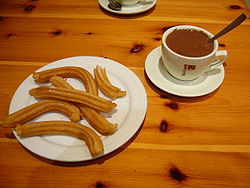- Churro
-
Churro 
Churros served with thick hot chocolateOrigin Alternative name(s) Tejeringos
PorrasPlace of origin Spain[citation needed] Dish details Course served breakfast, lunch, dinner, snack Serving temperature hot Main ingredient(s) Flour A churro, sometimes referred to as a Spanish doughnut, is a fried-dough pastry-based snack that has disputed origins. Churros are also popular in Latin America, France, Portugal, Morocco, the United States, Australia, and Spanish-speaking Caribbean islands. There are two types of churros in Spain. One is thin (and sometimes knotted) and the other is long and thick (porra). They both are normally eaten for breakfast dipped in hot chocolate or café con leche.
Contents
History
History is divided on how exactly Churros came to exist. Some say they were brought to Europe by the Portuguese. The Portuguese sailed for the Orient and returned from Ming Dynasty China to Portugal, they brought along with them new culinary techniques, including modifying the dough for You tiao also known as Youzagwei in Southern China, for Portugal. However, they modified it by introducing a star design because they did not learn the Chinese skill of "pulling" the dough (the Chinese Emperor made it a crime with capital punishment to share knowledge with foreigners). As a result, churros are not "pulled" but rather extruded out through a star-shaped die. [1]
Another theory is that the churro was made by Spanish shepherds, to substitute fresh bakery goods. Churro paste was easy to make and fry in an open fire in the mountains, where shepherds spend most of their time. [2] [3][citation needed]
Preparation
Churros are typically fried until they become crunchy, and may be sprinkled with sugar. The surface of a churro is ridged due to having been piped from a churrera, a syringe with a star-shaped nozzle. Churros are generally prisms in shape, and may be straight, curled or spirally twisted.
Like pretzels, churros are often sold by street vendors, who will often fry them freshly on the street stand and sell them hot. In Spain, Mexico, and Argentina, they are available in cafes for breakfast, although they may be eaten throughout the day as a snack as evident in Nicaragua. Specialized churrerías can be found in the form of a shop or a trailer during the holiday period. In Colombia they can be found in the streets but they are thin and shaped like a ring.
The dough is a mixture of flour, water and salt. Some versions are made of potato dough.
Variations
In southern, southwestern and southeastern Spain the word churro usually refers to the thicker variant, called porra elsewhere. The thicker variant is usually fried in the shape of a continuous spiral and cut into portions afterwards. The center of the spiral is thicker and softer, and for many a delicacy in itself.
In parts of South East Spain, a much thinner dough is used which does not allow for the typical ridges to be formed on the surface of the churro. The final result has therefore a smooth surface and is more pliable and of a slightly thinner diameter than standard Spanish churros. Another difference is that sugar is never sprinkled on them as the flavour is not considered suitable.
Filled, straight churros are found in Cuba (with fruit, such as guava), Brazil (with chocolate, doce de leite, among others), and in Argentina, Peru, Chile and Mexico (usually filled with dulce de leche or cajeta but also with chocolate and vanilla). In Spain they have a considerably wider diameter to allow for the filling. In Uruguay, churros can also come in a savoury version, filled with melted cheese.
See also
- Awwamaat
- Buñuelo
- Cuisine of the Community of Madrid
- List of fried dough foods
- Puff Puff, similar Nigerian recipe
- Tulumba
- You tiao
- Zalābiya
- Zlebia, the same sweet in the Maghreb (North Africa)
Notes
- ^ "Churros: a secret history". http://www.theprisma.co.uk/2011/07/17/churros-a-secret-history/. Retrieved 2011-10-16.
- ^ "Churro Encyclopodeia". http://www.ifood.tv/network/churro. Retrieved 2011-04-02.
- ^ "Churros: The Hidden History". http://www.huffingtonpost.com/2011/08/18/churros-the-hidden-history_n_930791.html. Retrieved 2011-10-16.
Doughnut Varieties Doughnut • Awwamaat • Baursaki • Bear claw • BeaverTails • Beignet • Berliner • Bombolone • Boston cream doughnut • Brown Bobby • Buñuelos • Churro • Cider doughnut • Coconut doughnut • Cruller • Dutchie • Fasnacht • Filhós • Fried Coke • Fried dough • Fritelli • Fritter • Fritule • Funnel cake • Gosh Feel • Imarti • Jalebi • Jelly doughnut • Kleina • Klenät • Koeksister • Krafne • Kreple • List of fried dough foods • Long John • Loukoumades • Luther Burger • Malasada • Maple bacon donut • Maple bar • Meat doughnut • National Doughnut Day • Oliebol • Ox-tongue pastry • Pączki • Pastisset • Persian • Picarones • Potato doughnut • Prusurate • Sata andagi • Shuangbaotai • Smultring • Sopaipilla • Sour cream doughnut • Sufganiyah • Timbits • Toutin • Tulumba • Vada • Verhuny • Youtiao • Zalābiya • ZeppoleCompanies Categories:- Culture in Madrid
- Chinese cuisine
- Spanish cuisine
- Doughnuts
- Yeast breads
Wikimedia Foundation. 2010.



